How to run without running
LeBron James and the Lakers became the league's premier transition team by running smarter, not faster.

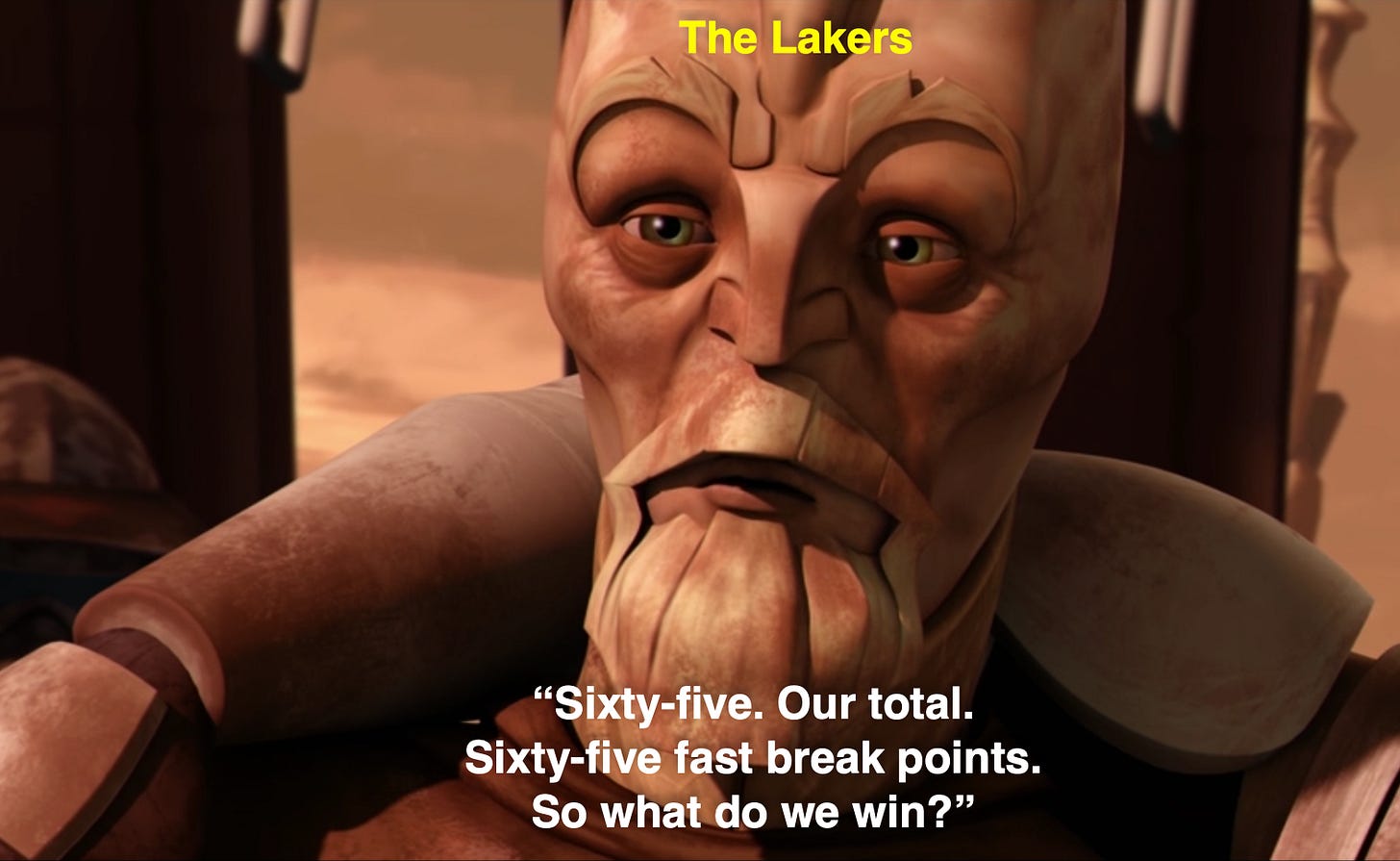

Dialogue adopted from this tweet.
When LeBron James arrived in Los Angeles, his coach knew exactly how he wanted to play with him. “We’re gonna play fast,” were Luke Walton’s words at the Lakers’ 2018 media day.
Most applauded the move. It’d be a waste to not run constantly with the NBA’s premier freight train joining a young, athletic roster that included Lonzo Ball, Brandon Ingram, and Kyle Kuzma. As LeBron himself said two weeks later, “We would be stupid to not utilize that as a strength.”
Walton and the Lakers backed up their preseason talk. James’ first game with the Lakers featured the most possessions of his NBA career. By December, LA’s games averaged three more possessions than they did the previous season, when they were the league’s second-fastest team. They ended the year as the fourth-fastest team in the league, and nearly 19 percent of their possessions were classified as transition opportunities – third-highest in the league, according to Cleaning the Glass. Specifically, 37.1 percent of their defensive rebounds ended up as transition sequences, second-most in the league.
Mission accomplished, right? Well … not exactly. LA finished 37-45 while ending up 24th in points scored per 100 possessions. Their overall transition scoring efficiency was 23rd in the league and 24th off live rebounds. Most importantly, James missed 27 games with a muscle injury and labored through many others after the turn of the new year.
In theory, the plan made perfect sense. Push the ball, get more possessions, and use the team’s collective athleticism to overwhelm teams. Sounds smart. In practice, it was a disaster. The Lakers ran often, but were bad at doing it. Instead of wearing the opposition out, they wore themselves out. Their floor balance faltered. Their defense fell apart. James looked his age for the first time in his career. The Lakers became a punching bag again. Yada yada yada.
That failure led to a massive course correction this summer. Walton got fired. The athletic kids left and proven vets came in. Frank Vogel, the coach behind of one of the slowest, defense-first contenders of the 2010s, was (eventually) hired. James moved to point guard. Vogel championed lineups with traditional centers alongside Anthony Davis. The Lakers’ pace slowed by three possessions per game. They started winning again.
In the midst of all that, something funny happened: the Lakers became the killer fast break team Walton wanted to build. Even weirder, they did it precisely because they don’t all run as fast as they can.
In the process, they’ve taught the rest of the league a lesson. Fast-break proficiency isn’t about running a lot. It’s more about running to the right places.
How effective is the Lakers’ fast break?
Some numbers, via Cleaning the Glass and PBP Stats:
The Lakers are second in the NBA in most points per possession in transition situations. They’re also second in most points/100 possessions added via running and fifth in transition frequency (i.e. the percentage of their total offensive possessions that are on the break).
They add more points in transition than any other team in the league when grabbing a defensive rebound in the run of play. Plus, they rank third in offensive efficiency after opponent missed field goals, whether they end in a fast break or not.
Their average speed off missed shots is middle of the pack, so they’re not rushing anything. They run more selectively than most teams near the top of the league.
That success scoring on the break masks their league-average half-court offense (15th in points per possession).
The only team that compares favorably in all of these measures is Toronto. Otherwise, the Lakers are the NBA’s running kings.
How do they do it anyway?
It starts with LeBron James, which is a pretty good place to start. While Walton envisioned LeBron galloping with his other young thoroughbreds, Vogel uses LeBron more like a dropback quarterback. It’s everyone else’s job to get open and it’s LeBron’s job to find them.
And find them he does, with alarming precision. Remember when I wrote that nobody threw outlet passes anymore? LeBron is the lone exception. Look at these deep routes.
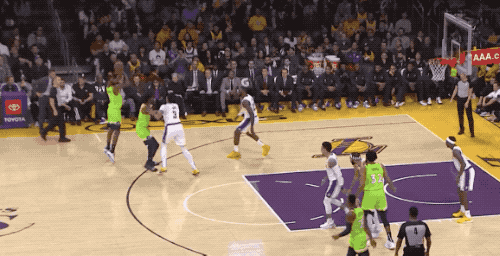
And intermediate pitch-aheads.
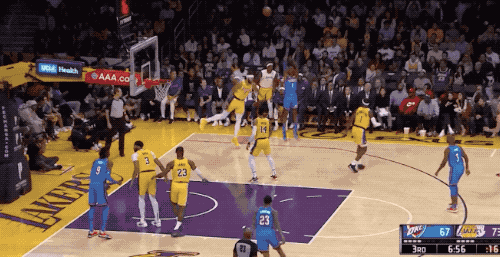
The reason the outlet pass has declined is that too many defenders are dropping back in coverage instead of chasing offensive rebounds. It’s too hard for anyone to throw on-target outlet passes around and over so many opponents.
Well, anyone except LeBron James. Nobody else would even try this pass, much less complete it.
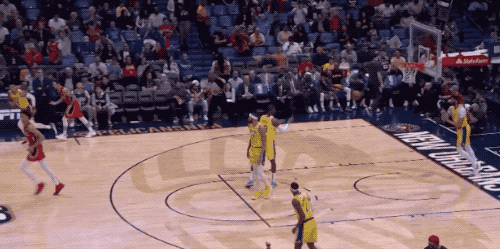
This is part of the Lakers’ larger reorientation around LeBron’s playmaking instead of his speed and power. In December, I wrote a piece for SB Nation showing how LeBron’s unprecedented passing accuracy masked the Lakers’ perimeter shooting weaknesses in half-court situations. They don’t need to sacrifice defense to open up the floor on offense because LeBron can slip perfect passes through tight windows like no other player — possibly ever.
That same principle holds true in transition. With LeBron able to drop passes into creases too tight for mere mortals, the Lakers are able to play a more conservative defensive scheme and still receive the quick-strike benefits you’d normally associate with a more aggressive one.
Let’s unpack that a bit by comparing the Lakers to Toronto. You’ll recall that the Raptors are the only other team with as effective a transition game as the Lakers’, according to Cleaning the Glass’ metrics. As I’ve written elsewhere, the Raptors use a hyperactive defensive scheme that forces crossmatches and confusion. The trade-off for all that scrambling is that Toronto is one of the league’s worst defensive rebounding teams — it’s hard to box out when small guys are switching with bigger ones and everyone closes out wildly to shooters. That’s a trade-off the Raptors correctly make, but a trade-off nonetheless. They need to junk the game up on defense to generate the optimal conditions to punish opponents on the break.
The Lakers, on the other hand, get all those transition benefits without having to accept Toronto’s trade-off. Because LeBron can slip passes into tight windows against prepared defenses, the Lakers don’t need to engineer the same confusion Toronto does in order to create wider fast-break openings. They can deploy a meat-and-potatoes defensive scheme that better fits their roster and doesn’t leave them vulnerable on the defensive glass.

But that’s only because they don’t ask LeBron himself to run anymore. He’s a pocket passer now, not the dual threat Walton envisioned. The Lakers realized they can find other players to run, but nobody else with LeBron’s vision. He’s the only player in the league — maybe in NBA history — that can make this all work.
You said “other players to run?” I thought you said the Lakers run without running?
OK, I didn’t mean that literally. Obviously someone has to run to force a fast break. So if it’s not LeBron, who is running?
This is where Anthony Davis comes in. LeBron may throw a great deep ball, but it helps when his primary receiver has such a wide catch radius. (Sorry if my football terminology is slightly off. I think you catch my drift).

Many criticized the Lakers for acquiescing to Davis’ request that he play power forward instead of center. Even now, there’s a sense that the Lakers can only win the title with Davis at the 5. That may be true, and indeed the Lakers’ closing lineups will almost certainly feature Davis at center.
But one ancillary benefit to pairing Davis with a more traditional big man is that he’s closing out on the perimeter more often. When that happens, Davis immediately leaks out to get behind the defense and/or pin a smaller man under the hoop. Playing the 4 — or at least defending more perimeter-oriented frontcourt players even while playing center — puts him in position to sprint downfield for LeBron’s passes.
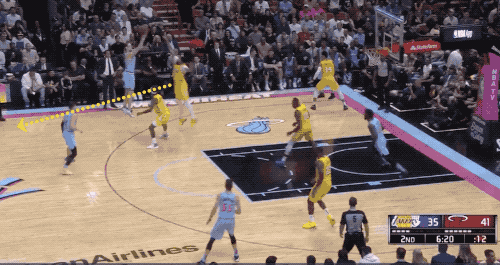
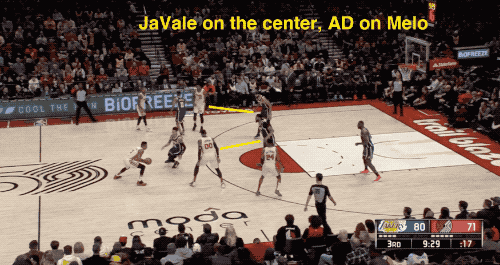
Davis is versatile and skilled enough to play different roles within the Lakers’ fast break. He can grab and attack himself.

Or, he can hang back as a trailer and drag screener for LeBron while the other big man sprints to the rim. His court sense is incredibly underrated; you’ll never see him running the same lane as JaVale McGee, Dwight Howard, or Kyle Kuzma.
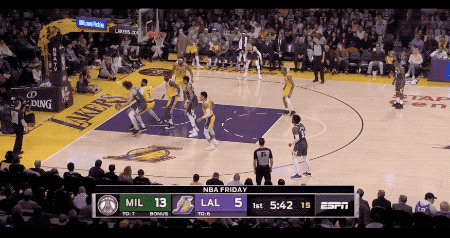
Davis is a special player who’s athletic enough to be the first wave, yet skilled and smart enough to be the second. Put another way, he’s the player Walton needed LeBron to be last year. Vogel has the luxury Walton didn’t: two one-of-a-kind superstars instead of one leading some unrefined youngsters.
Still, even Davis doesn’t have to sprint all the time. The unsung heroes that do are are the wings. They are the ones responsible for jetting to their assigned coordinates along the three-point line as soon as the Lakers secure the ball — and sometimes sooner. They are the first wave, and thus must be ahead of the ball at all times.
That first wave is crucial for a number of reasons. First, they present a threat that must be honored. If they aren’t, you’ll get a lot of this.
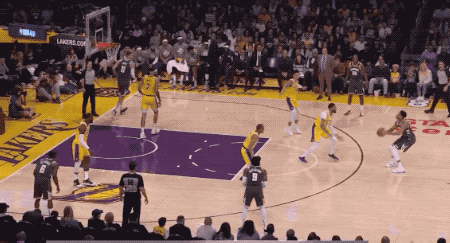
Or this.
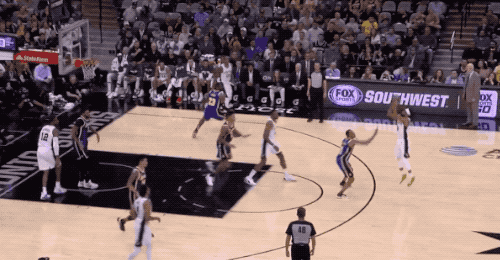
But there are other advantages to having two sprinters jetting ahead of the ball on every fast break. They are decoys that stretch out retreating defenders, which opens more space for drives to the rim. They’re also critical outlets for the ball-handler in case he draws a crowd and/or the defense collapses. There’s no ambiguity for LeBron when he drives to the hoop. His shooters are already in position ahead of him.
This job is highly specialized and requires a certain type of player. The necessary skills: speed, shooting accuracy on the run, discipline, and, crucially, no illusions of ball-handling glory. That’s perfect for Danny Green, Kentavious Caldwell-Pope, and Avery Bradley. All three know how to sprint in an instant, and all three possess the intelligence to line up properly around the perimeter. (The Lakers will miss having Bradley in Orlando, but at least J.R. Smith played a similar role on a LeBron-led team in the past).
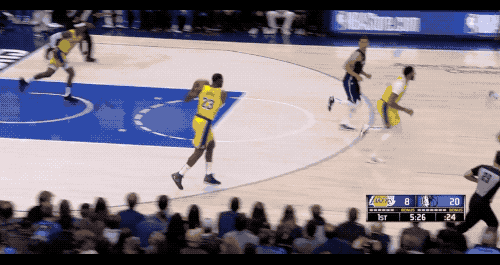
Role definition is therefore crucial to the Lakers’ transition success. LeBron is the quarterback, Davis is the No. 1 receiver, and the two wings are the decoys who occupy the flanks. Rigidity, normally a bug to a modern fast break, is a feature for this one.
That’s why the best way to think of the Lakers’ fast break is to imagine a half-court set that uses all 94 feet. The spacing looks exactly the same: star with the ball, two shooters on the wings, one big diving to the rim, and the other trailing the play or spotting up themselves. The Lakers are so well-drilled that they flow immediately into this setup when changing ends.

Why is offense surging like never before in the NBA? Simple: half-court offenses use more functional space than ever before. It’s a lot harder to spread five defenders over 30 x 50 feet than it is to do so over 20 x 50 feet. That’s simple math.
The concern in the preseason — one I tepidly shared — was that the Lakers’ didn’t have the shooting required to reach the “30” part of that equation. If they couldn’t reach the “30” part, how would they find enough spacing to maximize the potentially historic LeBron/Davis pick-and-roll game?
But I now realize we were thinking far too narrowly about this issue. In refining their transition game, the Lakers have created a far more difficult equation for defenses to solve. You know what’s harder than asking five defenders to cover 30x50 feet? Asking them to cover 94x50 feet.
So really, the Lakers don’t have a fast break at all. Instead, they just have the capability of creating a super duper spread half-court offense, one that no traditional basketball term can really describe.
After all, what’s more impossible to stop than LeBron and AD with space? LeBron and AD with twice as much space.


Mike, you were one of my favorite sports analysts at SBNation, and they're morons for letting you go.
When you say 20x46 and 30x46 , is out of bounds to feet on each side ?